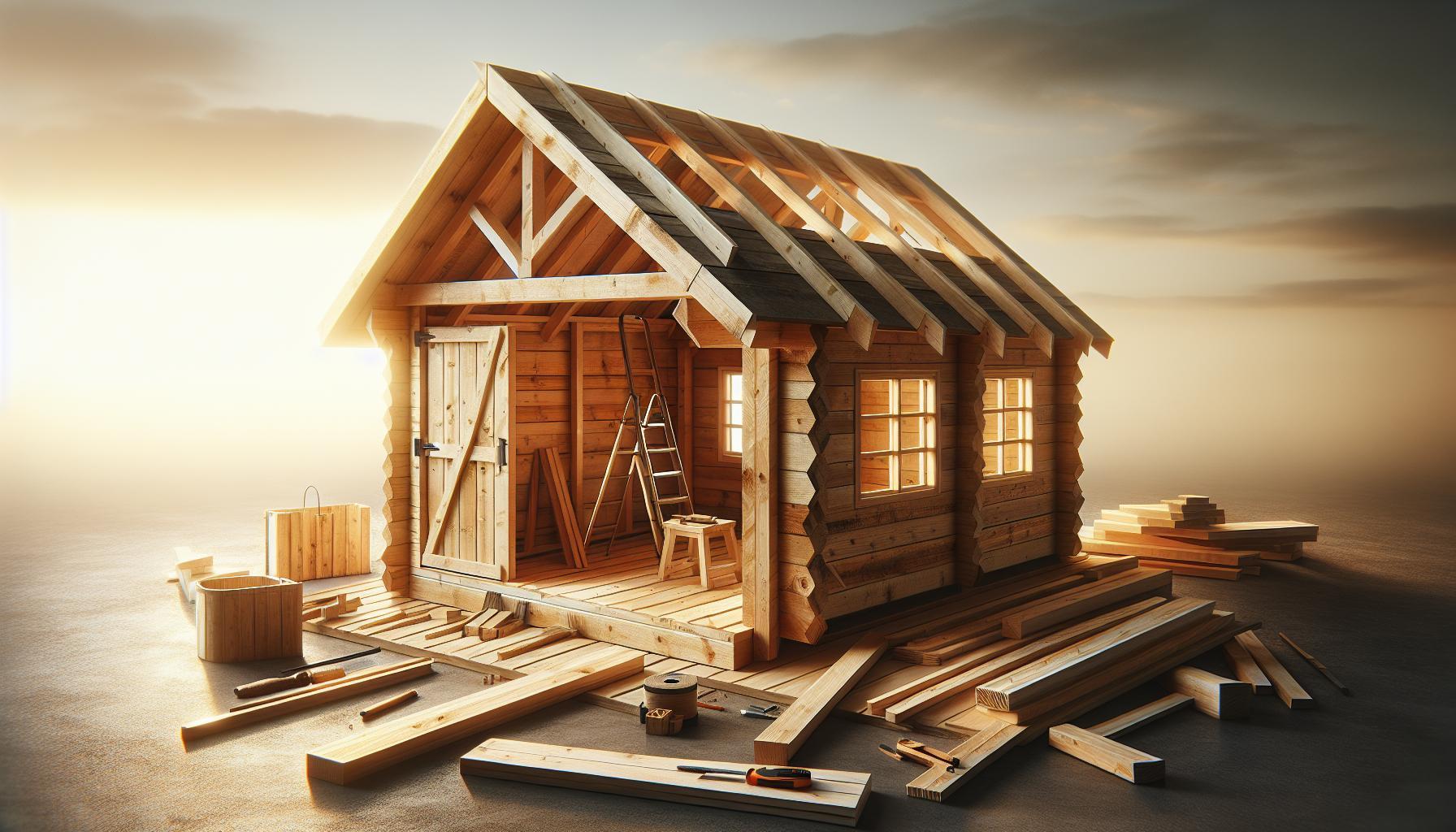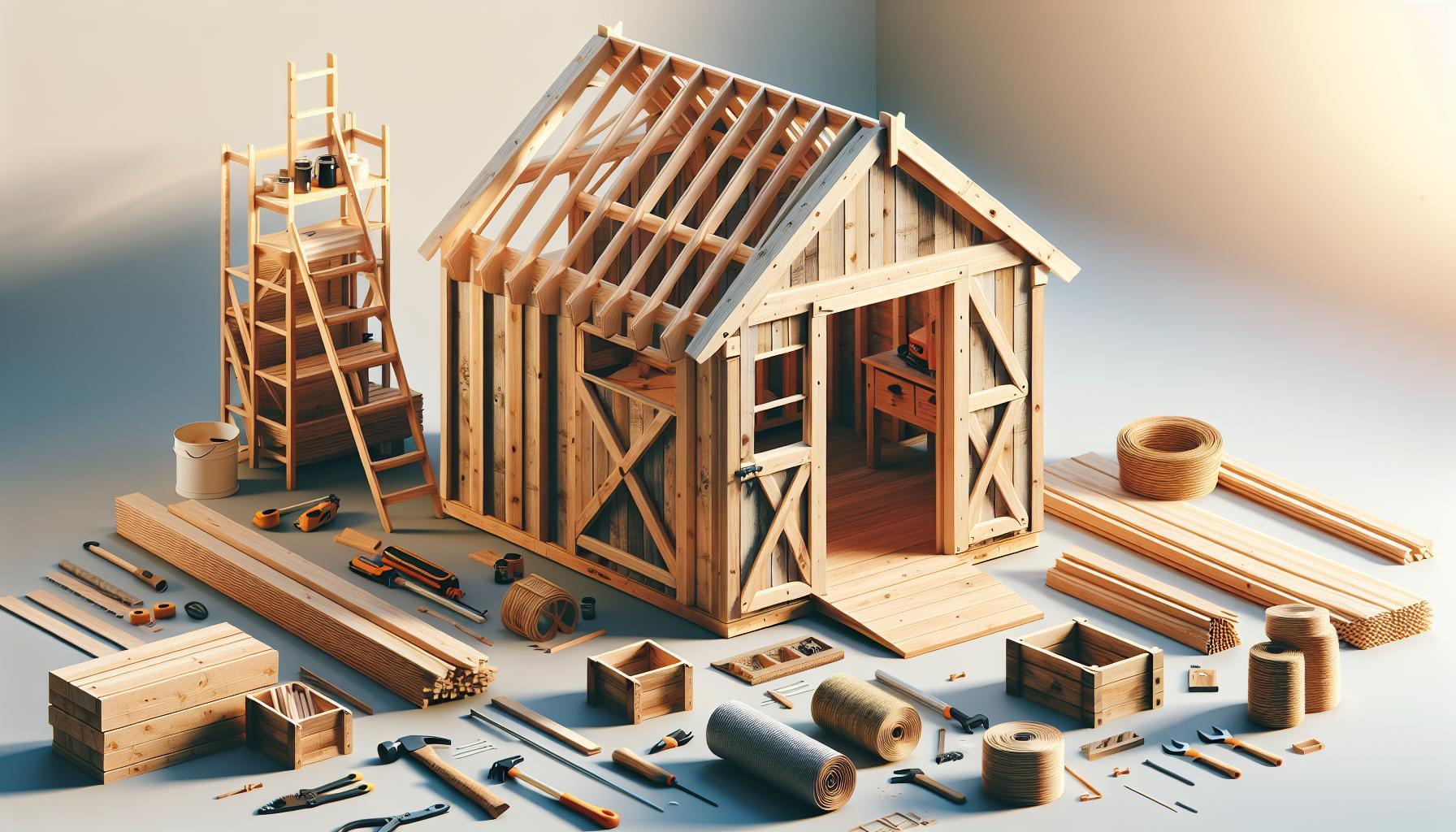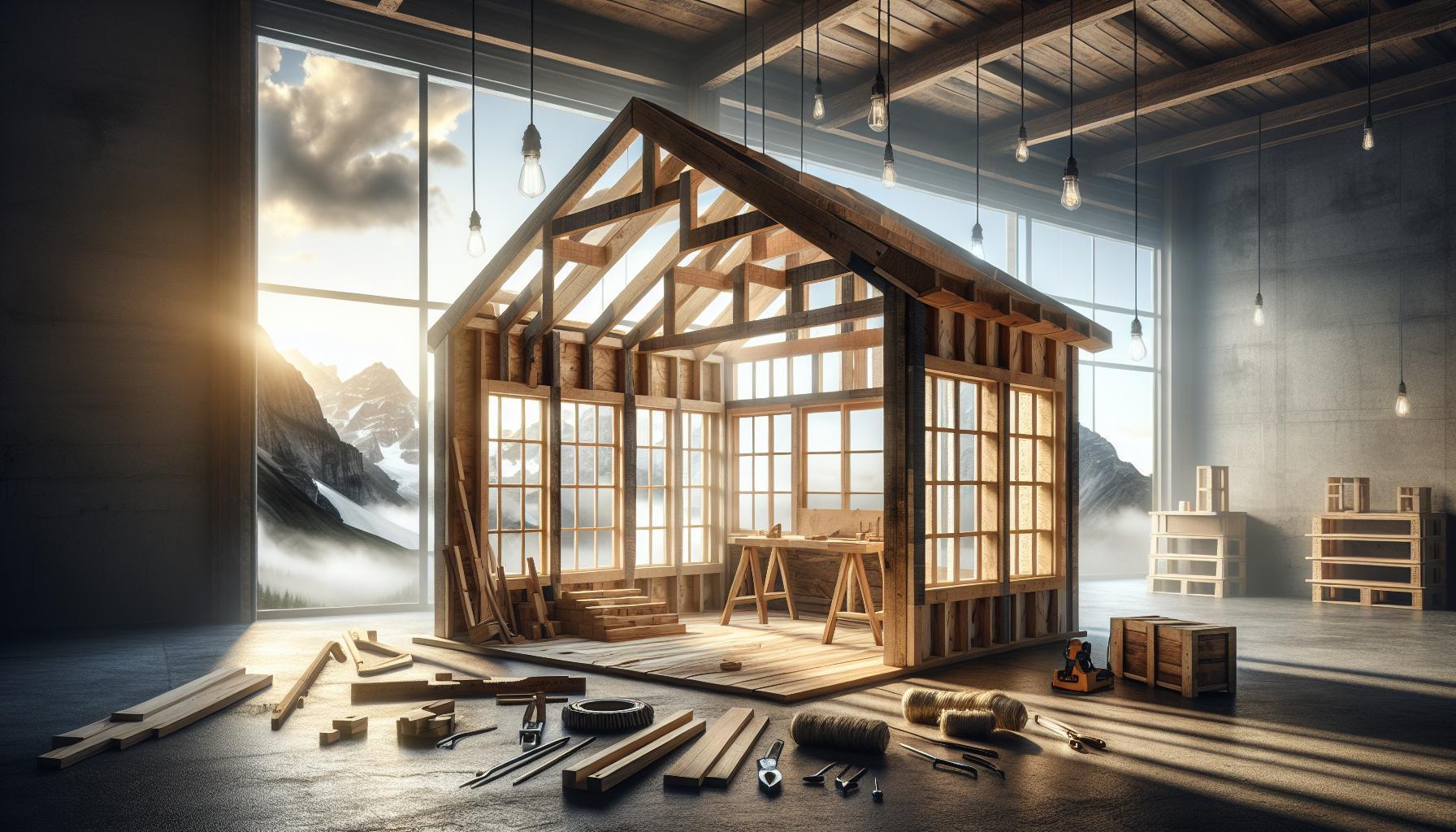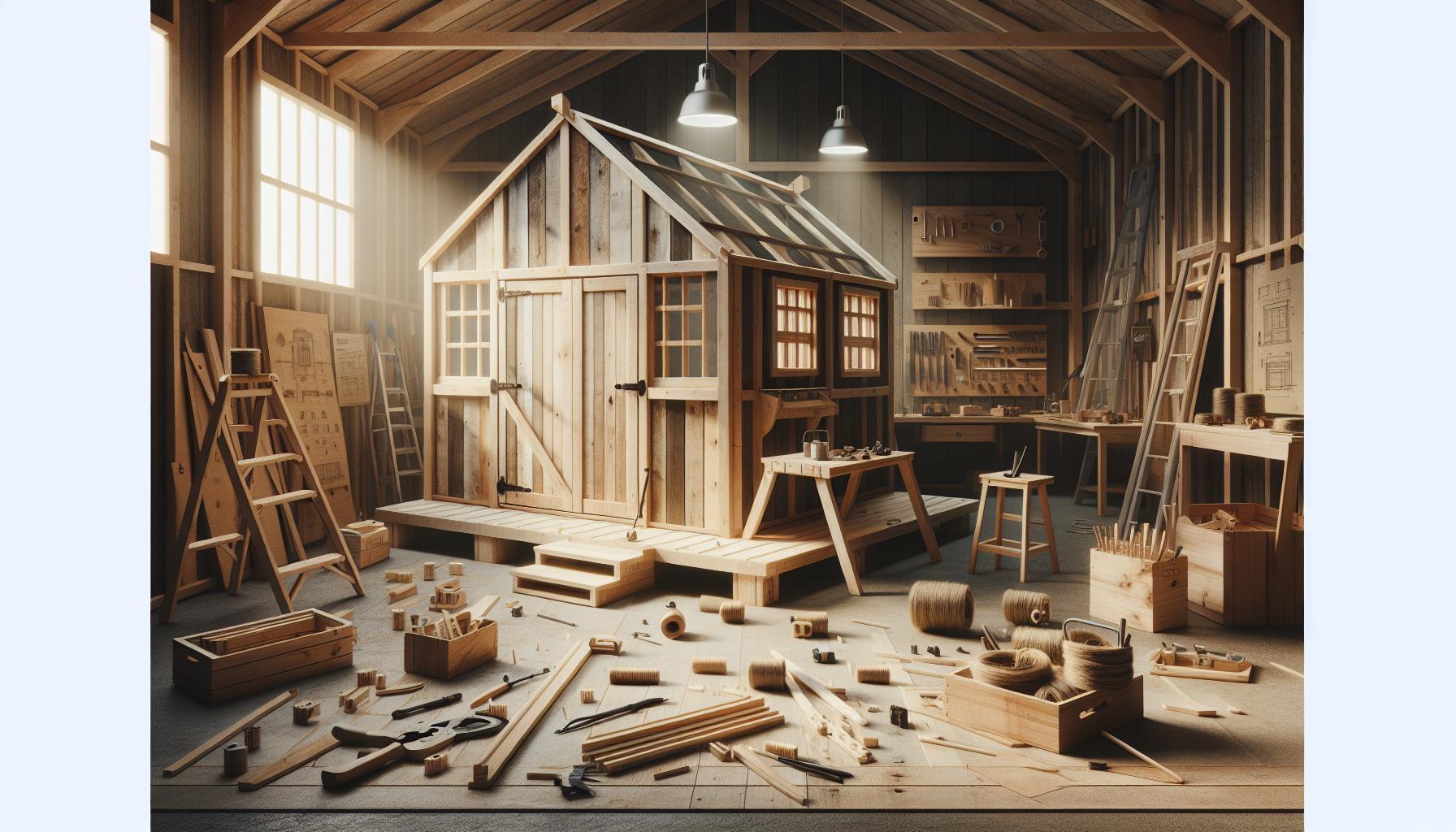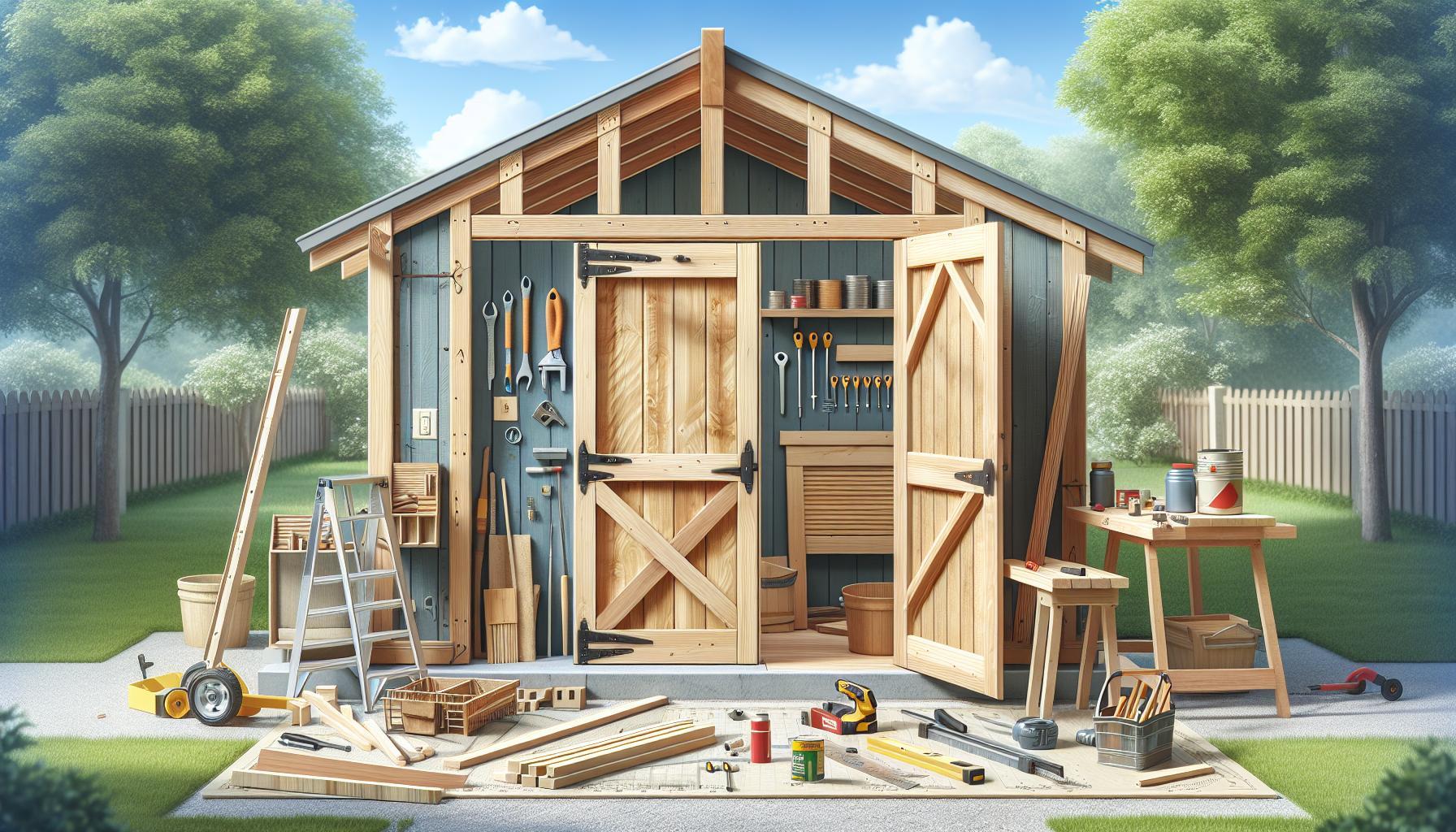Building a sturdy wooden shed can be a game-changer for organizing your outdoor space,yet many homeowners struggle with choosing the right design and materials.This guide offers timeless shed designs and practical tips to help you create a functional structure that enhances your property, providing essential storage while adding aesthetic value.
Understanding the Basics: What You Need to Know Before Building Your Shed
Building your own shed can be a rewarding project, offering both functional space and a sense of accomplishment. Before diving headfirst into construction, there are several key aspects to understand that will ensure your wooden shed stands the test of time and fits seamlessly into your property’s landscape. Knowing the fundamentals will save you time,resources,and the frustration that often accompanies DIY projects.
Planning Your Shed Design
The first step in building a wooden shed is solidifying your design.This critically important stage involves several considerations:
- Purpose: Determine what you will use the shed for—storage, a workshop, or perhaps a gardening haven. This will influence the size and design.
- Size: Decide on dimensions based on your available space and storage needs. A common size is 10×12 feet, but tailor it to fit your requirements.
- Style: Consider timeless designs that complement your property. From Cape Cod to modern shed styles, the right design will enhance your curb appeal.
Taking the time to map out these elements can prevent costly mistakes down the line. Use sketching software or graph paper to visualize your shed, and consider getting input from friends or family.
Selecting the Right Materials
Choosing the appropriate materials is crucial for the longevity and beauty of your shed. While wood is the predominant choice, understanding the best types is fundamental. Here are some commonly used options:
| wood Type | Benefits | Drawbacks |
|---|---|---|
| Cedar | natural resistance to rot and insects; attractive appearance. | Higher cost; may require treatments for color retention. |
| Douglas Fir | Strong, affordable, and readily available. | Susceptible to pests; may require more maintenance over time. |
| Pine | Cost-effective and easy to work with. | Less durable; requires treatment against rot. |
Your choice of wood will not only impact the aesthetic appeal of your shed but also its functionality and lifespan. Don’t forget to use weather-resistant hardware, as even the best wood can suffer from decay without proper fasteners.
understanding Local Regulations
Before constructing your shed, familiarize yourself with local zoning laws and building codes. Not only can this prevent potential fines, but it also ensures that your project is safe and complies with community standards. Key aspects to check include:
- Permit Requirements: Some areas may require a building permit, especially for larger structures.
- Property Lines: Make sure your shed is situated within your property boundaries to avoid disputes with neighbors.
- Environmental Regulations: If your property is near bodies of water or protected land, certain restrictions may apply.
These regulations can differ widely depending on your location, so it’s advisable to consult with your local building authority for guidance.
By grasping these basic principles—design, material selection, and compliance with regulations—you’ll set the foundation for a triumphant shed-building project that meets your needs while enhancing your property’s functionality and charm.
Selecting the Right Design: Timeless Styles for Every Backyard
When it comes to creating the perfect outdoor space, the design of your wooden shed plays a crucial role in harmonizing your backyard aesthetics. A well-designed shed is not just a practical storage solution; it can also enhance the visual appeal of your property, serving as a functional focal point that complements your home and garden. In the quest to discover how to build a wooden shed that embodies timeless design, it’s essential to consider various styles that stand the test of time while ensuring they fit your unique outdoor habitat.
Choosing the Right Shed Style for Your Backyard
To select the ideal design for your shed, contemplate the overall architecture of your home and the natural elements of your garden. Here are some timeless styles that can seamlessly integrate into any outdoor setting:
- Classic Gable Roof Shed: This design features a simple triangular roof, offering plenty of vertical space and a traditional look that pairs well with most home styles. The gable roof allows for easy water runoff, making it a practical choice for varying climates.
- Modern Flat roof Shed: Ideal for contemporary homes, this style emphasizes clean lines and minimalism. It’s a versatile option that can be outfitted with skylights to enhance natural light, creating a shining workspace or leisure area.
- Cottage-Style Shed: With charming details like window boxes and decorative shingles, the cottage-style shed adds a picturesque touch to your garden. This design is perfect for those looking to create an inviting retreat alongside their home.
- Rustic Barn Shed: A nod to classic rural aesthetics, the barn shed is characterized by its larger size and robust structure. This option often features sliding doors and can act as a multi-functional space for both storage and hobbies.
Understanding Your Needs
Before finalizing your choice,take inventory of your requirements.Ask yourself questions like: What will I use the shed for? How much space do I need? Will it be visible from the house? Analyzing your usage can guide you to features that enhance both function and style. Below is a straightforward comparison table to help match different shed styles with typical uses.
| Shed Style | Best For | Visual Aesthetic |
|---|---|---|
| Gable Roof Shed | General storage and hobby space | Traditional |
| Flat Roof Shed | Workspace or garden office | Modern |
| Cottage-Style Shed | Gardening tools and decorative items | Charming |
| Rustic Barn Shed | Large equipment or multi-purpose | Rustic |
By carefully considering these timeless designs and aligning them with your personal needs and the character of your property, you can create a wooden shed that not only fulfills its purpose but also elevates the overall ambiance of your backyard. The right choice will enable you to enjoy both functionality and aesthetic pleasure, making your outdoor space truly inviting.
Tools and Materials: Your Essential Checklist for Shed Construction
When embarking on the journey of constructing a wooden shed, the importance of having the right tools and materials cannot be overstated. A well-equipped workspace not only speeds up the project but also enhances the quality and durability of your shed—a key element when considering the timeless designs in “How to Build a Wooden Shed: Timeless designs for Your Property.” Below is a comprehensive checklist to help you gather all the essentials, ensuring a smooth building process.
Essential Tools for Shed Construction
Equipping yourself with the correct tools will enable you to tackle various phases of your shed building project effectively. Here are the crucial tools you’ll need:
- Circular Saw: Ideal for making straight cuts in plywood and lumber.
- Drill/Driver: necessary for drilling holes and driving screws into wood.
- Miter Saw: Perfect for making angled cuts, especially for trim work.
- Level: Ensures that your walls and roof structures are straight and even.
- Tape Measure: A must-have for accurate measurements of lumber and spaces.
- Impact driver: Helpful for driving screws quickly, especially in tough materials.
Essential Materials for Shed Construction
Choosing high-quality materials is pivotal in ensuring that your shed withstands the test of time and elements. Below is a categorized list of necessary materials for your shed construction:
| Material | Purpose |
|---|---|
| Pressure-Treated Lumber | Used for the foundation and any ground contact areas to resist decay. |
| Plywood or OSB Panels | Serves as the walls and roof sheathing, providing structural integrity. |
| Asphalt Shingles | A cost-effective roofing material that provides weather resistance. |
| Exterior Paint or Stain | To protect wood from UV degradation and moisture. |
| Galvanized Nails/Screws | Prevention of rust and corrosion, ensuring a long-lasting build. |
| Hardware (hinges, handles, etc.) | Necessary for door functionality and security. |
The right combination of tools and materials forms the backbone of a successful shed construction project. As you prepare for your build, remember that these selections not only impact the immediate construction but also influence the longevity and functionality of your shed in the long run. By following the guidelines and recommendations from “How to Build a Wooden shed: timeless Designs for Your Property,” you’ll be well on your way to creating a robust and aesthetically pleasing structure that enhances your outdoor space.
Step-by-Step Guide: From Foundation to Roof – Building Your Shed
Building a wooden shed can be an immensely rewarding project, offering not only a practical storage solution but also a stylish addition to your property. With timeless designs that can complement any landscape, constructing your shed from the ground up involves following a structured approach that will ensure durability and aesthetic appeal. Below is a detailed guide that will take you through the essential steps, from laying the foundation to finishing touches on the roof.
Foundation: Start with a Solid Base
Before you begin constructing your shed, it’s crucial to lay a solid foundation. A sturdy base will support your structure and enhance its longevity. Here are the foundational steps:
- Choose Your Location: Select a flat, well-drained area in your yard, avoiding low spots that may collect water.
- Mark Your Area: Use stakes and string to outline the dimensions of your shed. Typically, a 10×10 shed is a common size to start with.
- Excavate the Ground: Dig down about 4-6 inches to clear the area of grass and roots.
- install a Base: You can choose between a concrete slab or wooden skids. Concrete provides better durability against moisture, while wooden skids are easier for diyers.
Framing: Building the Walls
Once the foundation is set, building the frame of the shed is the next step. This stage will give your shed its shape and structural integrity.
- Gather Materials: You will need pressure-treated lumber for the bottom plate, standard lumber for vertical studs, and additional lumber for the top plates.
- Create Wall Panels: Construct each wall panel on the ground first. Use appropriate framing techniques like the ‘eight-foot rule’ to ensure your walls are straight and square.
- Raise the Walls: Carefully lift and secure each wall into place.ensure they are level and plumb before fastening them together.
Roofing: Topping it Off
the roof is the final touch that not only adds visual appeal but also protects the contents of your shed from the elements.
- Select Your Roofing Style: Decide between a gable, flat, or hip roof design based on aesthetics and regional weather conditions.
- Add Roof Framing: Start with the rafters or trusses, securing them according to your chosen design. Remember to overhang the eaves for better water runoff.
- Install Roofing Material: Whether you choose shingles or metal sheeting, follow manufacturer instructions for installation. Proper flashing and underlayment will prevent leaks.
Final Touches: Enhancing Function and Style
after successfully completing the foundation, framing, and roofing, it’s time to personalize your wooden shed for functionality and design.
- Paint or Stain: A fresh coat of paint or wood stain not only beautifies your shed but also protects it from the elements. Consider a color that blends with your home’s exterior.
- Add Windows and Doors: Ensure proper ventilation by installing windows and choose a durable door that offers security while fitting with the overall design.
- Organize Storage: Install shelves, hooks, and pegboards inside to maximize space and keep your tools organized.
By following these systematic steps to build your wooden shed, you can create a stylish and functional storage space that not only meets your needs but also enhances the beauty of your property. Consider this valuable resource an essential part of any home improvement or outdoor project plan, as it aligns well with timeless designs for your property.
Common Challenges and Solutions: What to Expect During Construction
During the process of constructing a wooden shed, many first-time builders encounter challenges that may disrupt the project workflow or lead to unforeseen complications. Understanding these common issues ahead of time can make a significant difference in how smoothly the construction progresses. Each stage of building—from planning and design to execution—presents its own unique hurdles, but proactive solutions can help you stay on track and achieve your goals.
Planning Mistakes
One of the most prevalent challenges in any construction project, including how to build a wooden shed, is inadequate planning. This can manifest as improper dimensioning, lack of materials, or even regulatory oversights regarding local zoning laws.
To combat these issues, start with a detailed blueprint that reflects not only your dream design but also considers the space available on your property.Consult with local authorities to ensure your shed complies with any building codes or permits required in your area. Here are some actionable steps to mitigate planning mistakes:
- Conduct a site assessment to determine the best location for your shed.
- Create a comprehensive materials list before starting to gather supplies.
- Double-check all measurements and dimensions before cutting any materials.
Weather Delays
Construction timelines can frequently be derailed by unexpected weather changes. Rain, snow, or extreme temperatures can create unsafe working conditions or damage materials, leading to downtime and additional costs.
To tackle this, always keep an eye on the weather forecast and try to plan your construction around stable conditions. When faced with harsh weather, consider having a temporary cover, like a tarp, or securing your materials away from the elements. Here’s how to navigate weather-related challenges effectively:
- Schedule work during the milder seasons—spring or early fall may be ideal.
- Have a backup plan for indoor work, such as organizing and preparing tools or materials.
- Invest in high-quality weather-resistant materials to prolong the usability of your shed.
Tools and Equipment Issues
another hurdle many face is complications with tools and equipment. Whether it’s faulty tools that break mid-project or simply not having the right tools for the job, these problems can lead to frustration and wasted time.
To avoid equipment-related setbacks, ensure all tools are in good working order before starting your project. Invest in necessary machinery or tools that increase efficiency, such as a circular saw or power drill, and familiarize yourself with their operation well ahead of time. Consider these tips for tool management:
- Create a checklist of all required tools and equipment prior to starting.
- Rent specialized tools if purchasing is not feasible for your budget.
- Set aside time for tool maintenance and repairs before the start of your project.
By anticipating these common challenges and preparing solutions accordingly, you can considerably streamline the process of building a wooden shed. Incorporating practical strategies ensures that your journey towards creating a timeless addition to your property remains as hassle-free as possible.
Adding Personal Touches: Customizing Your Shed for Functionality and Flair
Personalizing your shed is an possibility to reflect your style and enhance its functionality.Rather than a simple structure, it can become an extension of your home or garden, serving as a versatile space tailored to your needs. Whether you’re looking for extra storage, a workshop, or a quiet retreat, incorporating unique features can elevate your shed beyond a conventional utility space.
Functional Additions for Everyday Convenience
To ensure your shed meets your day-to-day requirements, consider integrating practical elements that enhance usability. Here are some functional ideas to implement:
- Built-in Shelving: Install sturdy shelves to maximize vertical space. Adjustable shelving can accommodate various items—tools, garden supplies, or seasonal decorations—making it easy to keep things organized.
- Workbench: If you plan to use your shed as a workspace, a customizable workbench can be pivotal. Consider a folding table or one with ample storage space for your tools, ensuring a clutter-free environment.
- Hooks and Pegboards: Install hooks or pegboards on the walls for easy access to frequently used items. This keeps everything from gardening tools to sports equipment readily available while freeing up floor space.
Aesthetic Enhancements for Charisma
While functionality is key, the charm of your shed shouldn’t be overlooked. Adding visual flair can make your shed a pleasing part of your landscape.Here are several creative ideas:
- Paint and Finishes: A fresh coat of paint in vibrant or coordinating colors can breathe new life into your shed.Consider weather-resistant finishes to ensure longevity.
- Landscaping: Surround your shed with plants, flowers, or decorative stones. A pathway leading to it can establish a welcoming ambiance while integrating it into your garden design.
- Custom Signage: Adding personalized signage can give your shed character. Whether it’s a nameplate or a whimsical quote, it adds a unique touch that can make your space feel special.
| Element | Function | Style Options |
|---|---|---|
| Built-in Shelving | Storage & Organization | Wood, Metal, Adjustable |
| Workbench | Crafting & Repairs | Foldable, Stationary, Multi-level |
| Paint Colors | Aesthetic Appeal | Pastel, Bold, Earth Tones |
By thoughtfully combining functionality and charm, you create a personalized oasis that not only serves practical purposes but also enriches your property’s overall aesthetic. Embrace these tips while planning your shed, and watch as it transforms into a beloved feature of your outdoor space, perfectly complementing the timeless design principles outlined in the guide on how to build a wooden shed.
Maintenance Tips: Keeping Your Wooden Shed in Tip-Top Shape
Keeping your wooden shed in excellent condition is essential for ensuring its longevity and functionality. Like any outdoor structure, wooden sheds are susceptible to the elements, which can lead to deterioration over time. Fortunately, with a little attention and care, your shed can remain a reliable storage solution or workspace for years to come. Here are some practical tips to help you maintain your wooden structure while preserving its aesthetic charm.
Regular Inspections
Conducting periodical checks is vital for identifying potential issues before they escalate. Aim to perform inspections at least twice a year,ideally in the spring and fall. During these inspections, look for:
- Signs of rot or decay, especially at the base of the shed and any exposed wood.
- Mold or mildew, especially in shaded or damp areas.
- Cracks or gaps in the wood that may allow moisture or pests to enter.
- Sagging doors or windows that may indicate shifting or structural problems.
By addressing these concerns promptly, you can ensure the integrity of your shed remains intact.
Protecting the Wood
To fend off rot,termites,and other threats,it’s crucial to treat your wooden shed with the right protective applications. here are some recommended approaches:
- Stain or sealant: Applying a quality sealant or stain once a year can protect against moisture penetration and UV damage. Choose products specifically designed for outdoor wood.
- Tarring the Roof: If your shed has a wooden roof, consider applying a tar-like substance to protect it from water damage. This will extend the lifespan of the roof significantly.
Also, ensure any areas that come into direct contact with the ground, like posts or skids, are treated with a wood preservative to prevent moisture accumulation.
Cleaning and Maintenance
Regular cleaning will not only keep your shed visually appealing but also extend its life. Follow these simple steps:
- Clear out any debris, leaves, or dirt around the shed’s foundation and roof area.
- Power wash the exterior periodically to eliminate dirt and mildew buildup; however, be cautious not to damage the wood.
- Inspect and clean gutters or roof vents to prevent water pooling.
In the case of persistent mold or stains,consider using a mixture of water and bleach to tackle these issues,but always test on a small area first to avoid discoloration.
Table: Seasonal Maintenance Checklist
| Season | Maintenance Task |
|---|---|
| Spring | Inspect for winter damage; clean gutters; apply sealant/stain. |
| Summer | Check for pest infestations; clean exterior; ensure ventilation is working. |
| Fall | Remove debris; inspect for damage; prepare for winter; touch up stains. |
| Winter | Shovel snow away from the shed; monitor for ice formation. |
Implementing these maintenance strategies will not only keep your wooden shed functioning effectively but also preserve its aesthetic beauty. By investing a little time into regular upkeep, you can enjoy a lasting asset to your property that showcases the timeless designs explored in “How to Build a Wooden Shed: Timeless Designs for Your Property.”
Sustainable Practices: Eco-Friendly Options for Your Shed Project
Building a wooden shed not only provides additional storage space but also presents an excellent opportunity to embrace sustainable practices that contribute to a healthier environment. With the growing emphasis on eco-friendly construction, integrating environmentally conscious choices into your shed project can significantly influence your home’s overall ecological footprint. From sourcing materials locally to implementing energy-efficient designs, there are numerous ways to ensure that your shed not only meets your needs but also respects the earth.
Choosing Sustainable Materials
The foundation of any eco-friendly build starts with the materials you select. Opting for sustainably harvested wood is crucial. Look for certifications such as the Forest Stewardship Council (FSC) label, which guarantees that the timber comes from responsibly managed forests. Here are some options you might consider:
- Cedar: Naturally resistant to decay and insects, cedar is a durable choice that also offers a stunning appearance.
- Reclaimed Wood: Using salvaged timber not only reduces waste but adds character and history to your shed.
- Bamboo: A rapidly renewable resource, bamboo grows much faster than traditional wood, making it an excellent eco-friendly alternative.
Designing for Energy Efficiency
Incorporating energy-efficient features into your shed can further enhance its sustainability.Here are some strategies for designing an energy-efficient structure:
- Natural Ventilation: Position windows to allow for cross-ventilation, which minimizes the need for artificial cooling.
- solar Panels: Consider installing solar panels on the roof to power lights and tools, reducing reliance on the grid.
- Insulation: Insulating your shed can definitely help regulate temperature, making it more cozy year-round while reducing energy costs.
Water Conservation techniques
Integrating water-saving features into your shed can further your commitment to sustainability. Simple strategies include:
- Rainwater Harvesting: Install a rain barrel to collect water runoff from the roof,which can be used for watering plants or cleaning.
- Permeable Surfaces: Use permeable materials for walkways and the area surrounding the shed, allowing for natural drainage and reducing runoff.
| Material | Benefits |
|---|---|
| Sustainable Timber | Environmentally friendly, reduces deforestation |
| Reclaimed Wood | Reduces waste, unique aesthetic |
| Bamboo | Fast-growing, carbon-sequestering |
By prioritizing sustainable practices in your shed construction, you not only contribute to environmental conservation but also create a space that embodies your values and integrity. These eco-friendly choices will serve as a testament to your commitment to sustainability, offering long-lasting benefits for both your property and the planet.
Frequently Asked Questions
How to build a Wooden Shed: Timeless Designs for Your Property?
Building a wooden shed involves careful planning, selecting materials, and following a systematic approach. Start with a solid design that fits your property needs and local regulations. Grab basic tools, and ensure your skills match the project requirements.
Choosing the right design is essential. Such as, you can opt for a classic gable roof or a modern lean-to shed. Consider utilizing high-quality materials like pressure-treated wood for added durability. For complete guidance on various designs and tips, check out our full article on shed designs.
what materials do I need to build a wooden shed?
To build a wooden shed, you typically need wood for the frame, siding, roof, and floor, along with nails, screws, and hardware. Essential materials include plywood for the floor and framed walls, and roof shingles for weather protection.
Additionally, you may want to invest in insulation, paint, and sealant to protect your shed from the elements. Always source quality materials to ensure longevity,especially if your shed will store valuable tools or equipment.
Why does the design of my shed matter?
The design of your shed impacts functionality, aesthetics, and resale value. A well-planned design not only makes the best use of space but also complements your property’s architecture.
As a notable example, a traditional gable shed may suit a classic home, while a sleek, modern design may fit better with contemporary architecture. Consider your landscape and intended shed use—an organized workshop requires a different design compared to a garden storage shed.
Can I customize my wooden shed design?
Absolutely! Customizing your wooden shed design allows you to tailor features to your specific needs, such as additional windows for natural light or built-in shelving for organization.
You can even modify the roof pitch,add overhangs,or include a workbench. The customization possibilities are endless, making it a fun project for DIY enthusiasts eager to express their creativity. Use our ideas on custom shed ideas for inspiration.
How long does it take to build a wooden shed?
The time to build a wooden shed varies based on size and complexity but generally ranges from a weekend to several weeks. A simple, small shed can be completed in 1-2 days with a couple of helpers.
Plan for additional time if you’re constructing larger or more complex designs. Always factor in weather conditions and material delivery delays. Adequate preparation helps streamline the process and allows for a more enjoyable DIY experience.
What tools do I need for building a wooden shed?
Essential tools for building a wooden shed include a circular saw, hammer, drill, level, and measuring tape. These tools will help you accurately cut, assemble, and secure your shed.
Consider also investing in safety gear,such as goggles and gloves,to protect yourself during construction. Having the right tools at your disposal not only improves efficiency but enhances the overall quality of your shed.
Why should I choose wood for my shed instead of metal or plastic?
Wood provides a timeless aesthetic and excellent insulation properties, making it a popular choice for sheds. It can be easily customized and blends well with natural surroundings.
While metal and plastic options offer durability, they often lack the warmth and character of wood.Plus, wood allows for easy modifications and repairs, making it ideal for DIY projects.
Future Outlook
As you embark on the rewarding journey of building your own wooden shed, remember that each step is an opportunity to enhance your skills and create something truly meaningful for your property. We’ve covered timeless designs, essential materials, and easy-to-follow construction techniques that cater to all DIY levels. Embrace the challenges along the way; they are stepping stones to mastery.
Don’t hesitate to revisit key points for clarification or further inspiration. Whether you’re a seasoned builder or a first-timer, know that every effort you put in will be reflected in the quality of your shed. As you construct,let the passion for craftsmanship guide you,and feel free to share your triumphs and questions with fellow enthusiasts in the DIY community. Your shed is absolutely possible, and it can be a proud testament to your hard work and creativity. So gather your tools, and let’s get started—there’s a beautiful project awaiting your personal touch!

